Including American Goldfinches.
I didn’t go out shooting yesterday so I had no plans to post to my blog today but circumstances intervened. Yesterday morning, after blustery weather the day before, my back yard birds were feasting on seeds from the amaranth plants in my poor excuse for a vegetable garden. So I couldn’t resist setting up my tripod and documenting their banquet from the comfort of one of my patio chairs.
The early morning light was dappled and highly variable, which explains my camera settings and shutter speeds. While the birds were feeding on the mostly vertical amaranth plumes they typically had their backs to me. So for today’s post I’ll concentrate on a single female American Goldfinch who was near the very tip of one of the plumes, so she was more isolated from the rest of the setting and background.
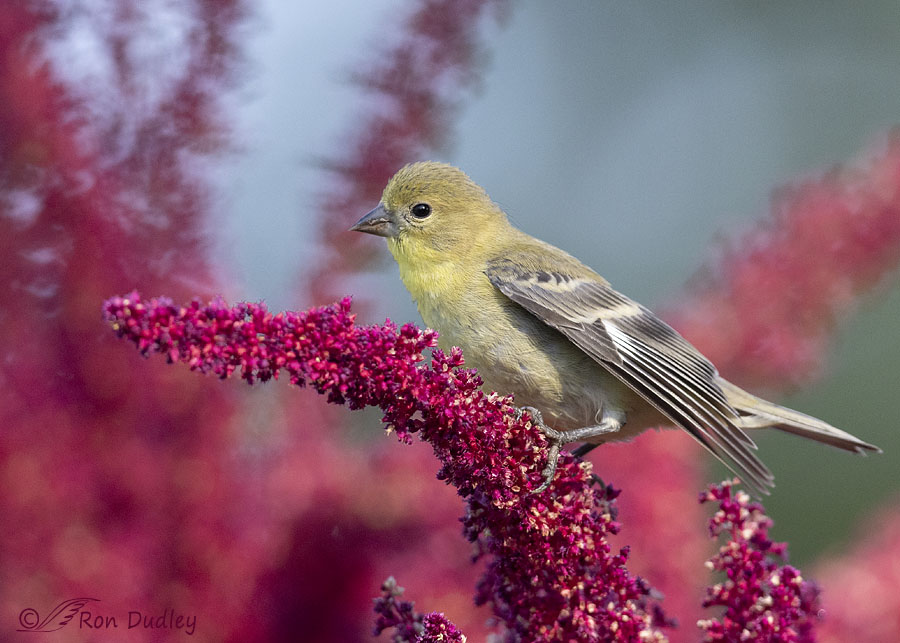
1/1600, f/5.6, f/1600, Canon R5, Canon EF500mm f/4L IS II USM + 1.4 tc, not baited, set up or called in
Amaranth plumes are nothing if they aren’t colorful. I like their reds when combined with the yellow/golds of goldfinches.
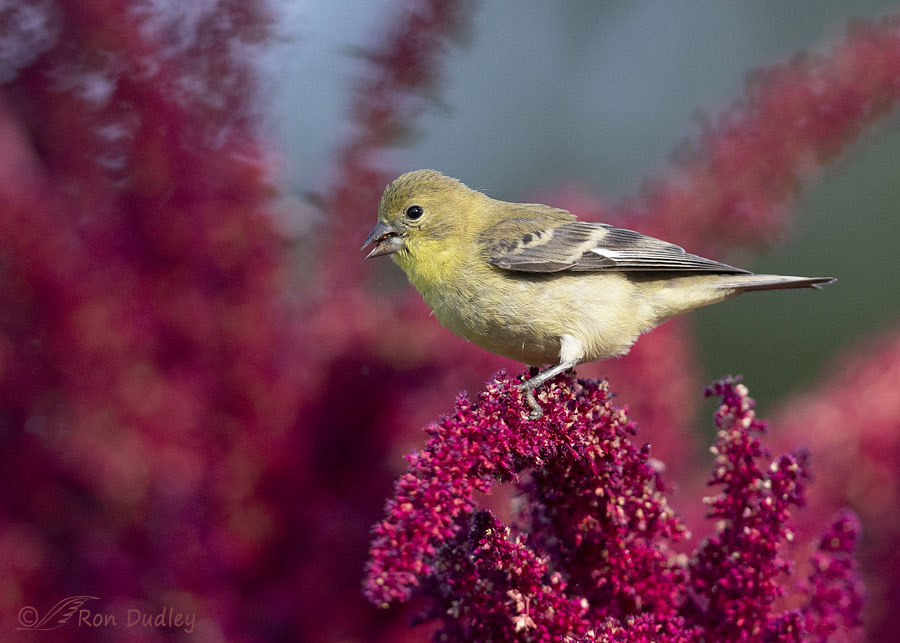
1/2500, f/5.6, f/1600, Canon R5, Canon EF500mm f/4L IS II USM + 1.4 tc, not baited, set up or called in
Sometimes they were flitting around from plume to plume so often I couldn’t get focused on them before they took off, but this little lady had staying power. She fed on seeds from this plume for long enough to allow me to get hundreds of shots of her before a busybody House Finch chased her off.
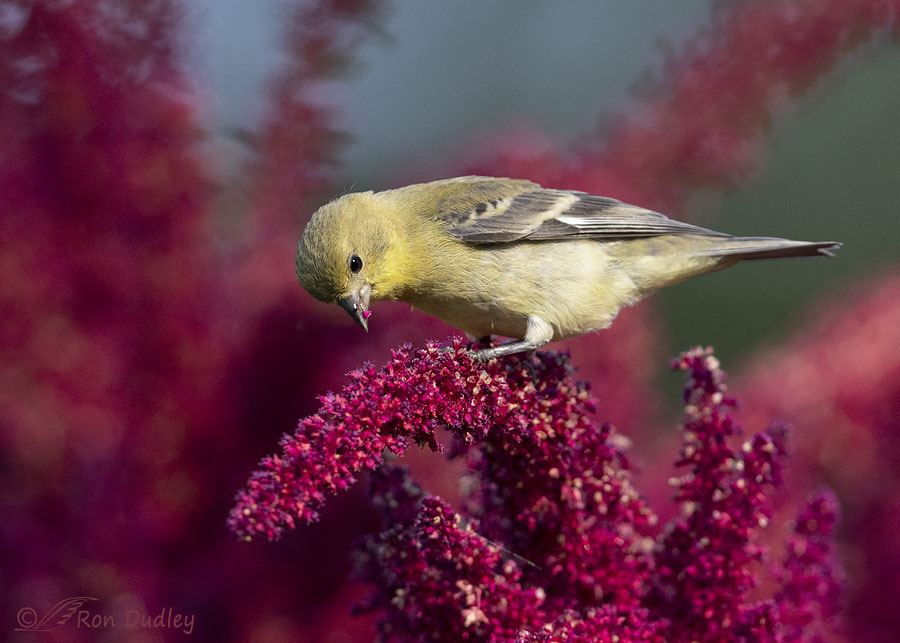
1/2000, f/5.6, f/1600, Canon R5, Canon EF500mm f/4L IS II USM + 1.4 tc, not baited, set up or called in
There was a glut of tiny seeds to choose from but she seemed pretty picky about which ones she preferred. Sometimes she appeared to carefully inspect them visually before choosing one.
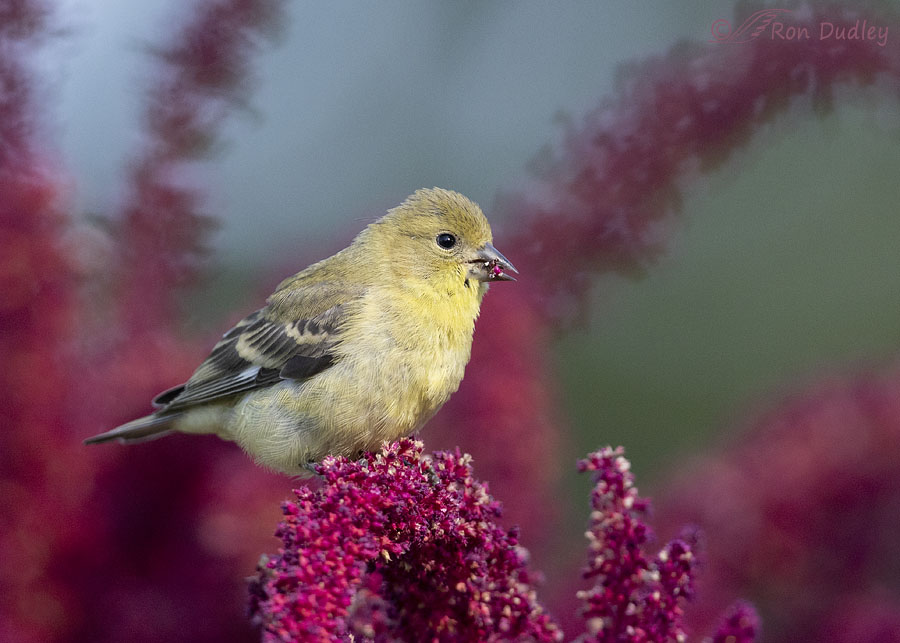
1/2000, f/5.6, f/1600, Canon R5, Canon EF500mm f/4L IS II USM + 1.4 tc, not baited, set up or called in
No matter which species I was photographing, usually an American Goldfinch or a House Finch, they usually had those telltale little red seeds (or their husks) stuck to their bills.
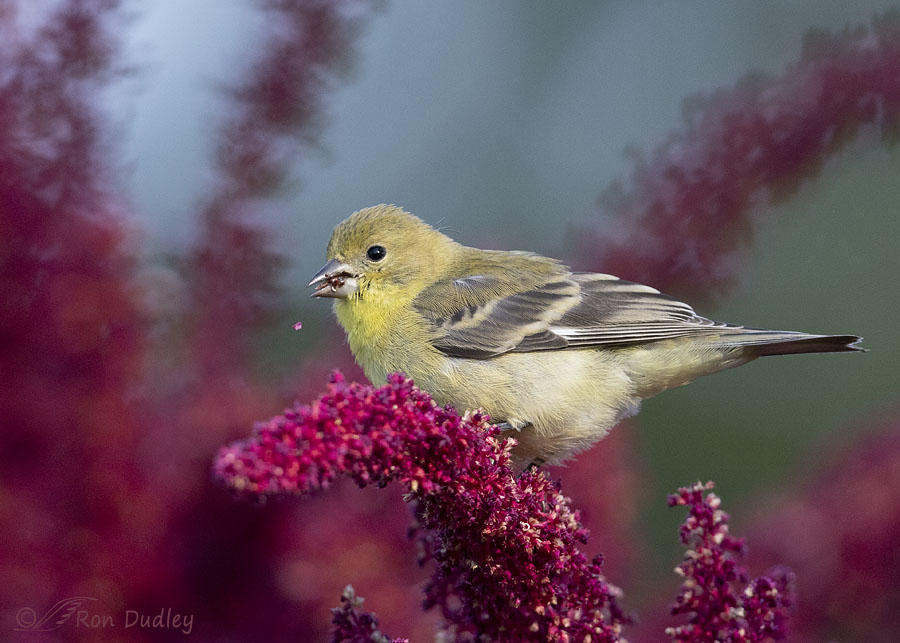
1/2000, f/5.6, f/1600, Canon R5, Canon EF500mm f/4L IS II USM + 1.4 tc, not baited, set up or called in
If she dropped a seed or two in the process, she didn’t care. She just…
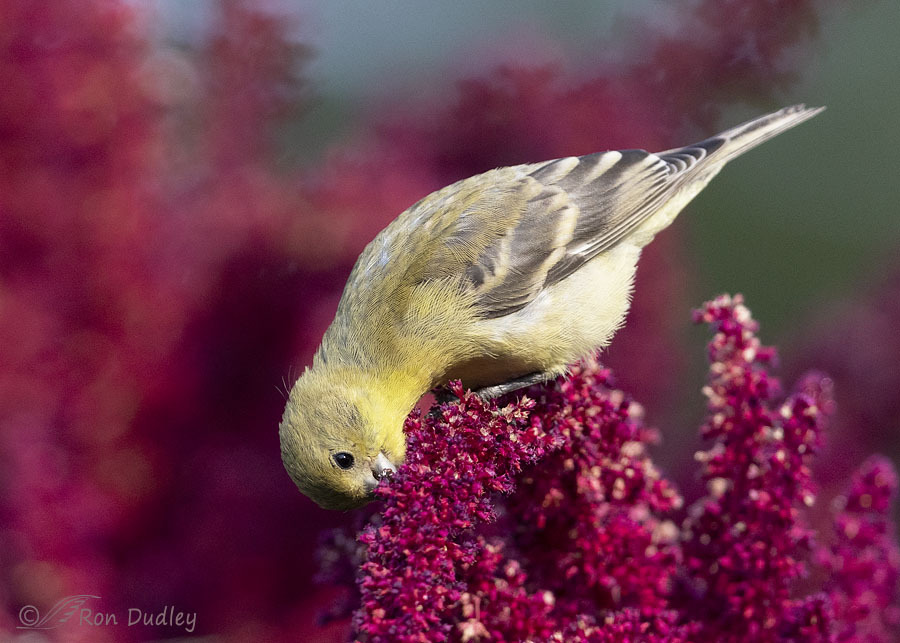
1/2000, f/5.6, f/1600, Canon R5, Canon EF500mm f/4L IS II USM + 1.4 tc, not baited, set up or called in
helped herself to more.
Sometimes she had most of her face buried deep in the plume for long enough that I had the impression that she was choosing her preferred seeds by feel rather than by sight. For those shots her eye was typically hidden in the plume so I’m not including any of them.
She stayed here so long she obviously loved this particular feeding spot but eventually…
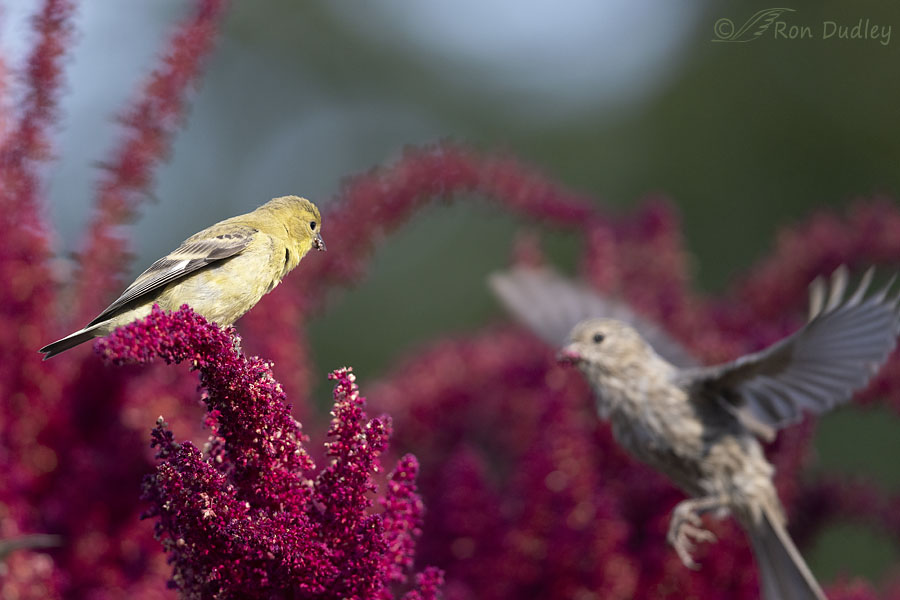
1/2500, f/5.6, f/1600, Canon R5, Canon EF500mm f/4L IS II USM + 1.4 tc, not baited, set up or called in
a pushy House Finch displaced her.
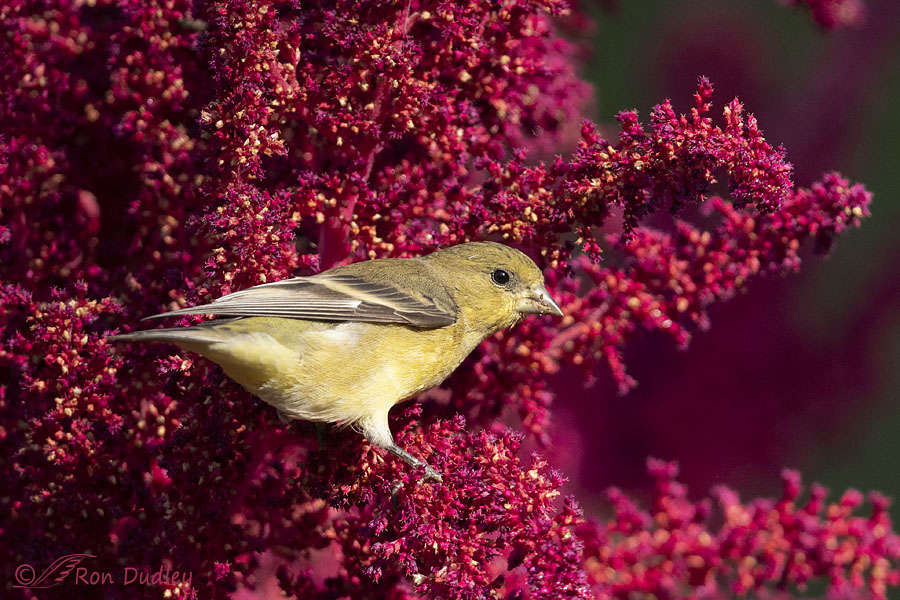
1/2500, f/5.6, f/1600, Canon R5, Canon EF500mm f/4L IS II USM + 1.4 tc, not baited, set up or called in
This is a different goldfinch on a different catkin-like flower plume (technically a cyme). Each one of those tiny red flowers produces a single, round and apparently nutritious seed.
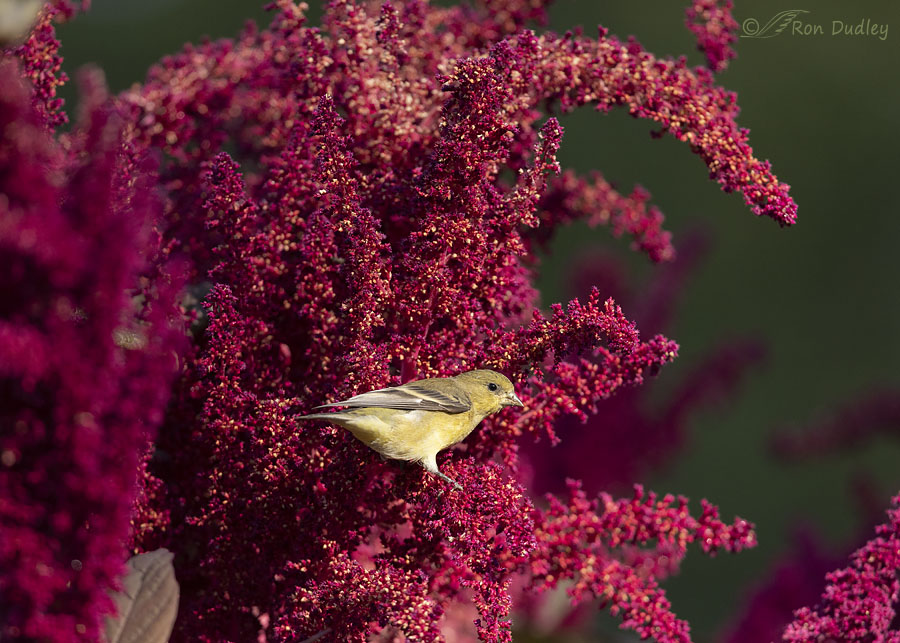
And man, are there ever lots of them to choose from. This is mostly a single plume and each amaranth plant has about a dozen plumes, from very large to quite small.
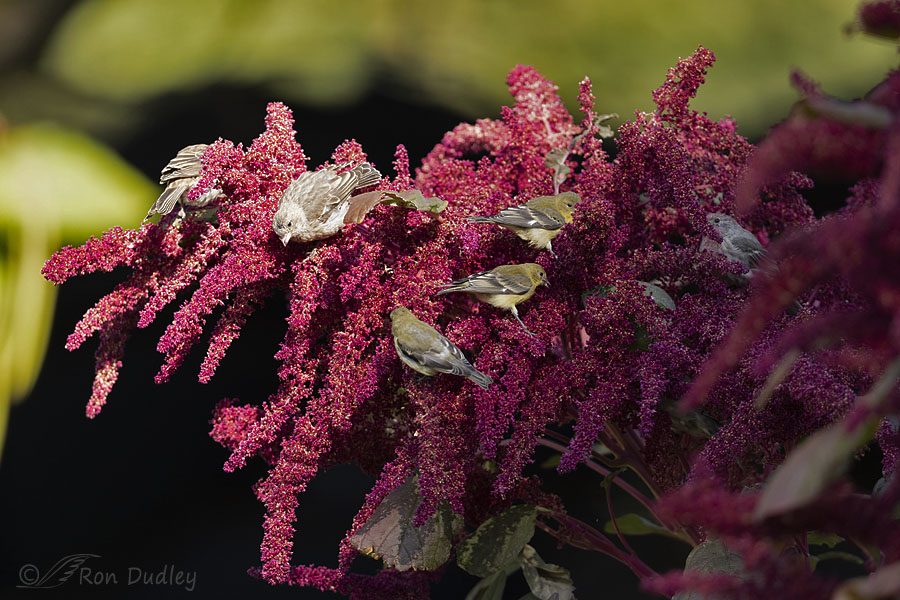
1/1600, f/5.6, f/1600, Canon R5, Canon EF500mm f/4L IS II USM + 1.4 tc, not baited, set up or called in
And the birds sure love those seeds, at least many of them do. And for my preference, amaranth has another advantage. House Sparrows are the most common bird in my back yard but I seldom see House Sparrows feeding on amaranth seeds. They much prefer my feeder and I’m fine with that.

Cell phone photo
This was my shooting scenario for the photos I took yesterday. This year the largest of my amaranth plants (by now they’re past their prime) is 9 1/2′ tall but in previous years they’ve been even taller and produced larger plumes. This year, due to our unusually hot temps, our drought and my current physical limitations, my entire garden did poorly. The amaranth did better than most. My spaghetti squash did pretty well too but that’s probably because it gets more shade from the trees on the left.
Even my tomatoes produced poorly this year. Earlier this summer I promised my neighbor Ryan that he’d be the recipient of my excess tomatoes but I haven’t had enough to share with him until yesterday. I feel bad about that.
Hopefully we’ll both have a bounty of tomatoes for the next few weeks, to match the current bounty of amaranth seeds for the birds.
Ron
Correction: Apparently these are Lesser Goldfinches, not American Goldfinches. Two knowledgeable blog followers have pointed out my error in the comments below. Hate it when I do that…


The tomatoes are delicious, Ron! Well worth the wait. These photos turned out great.
I thought the close shot of the Goldfinch in amaranth was my favorite until I saw that cluster of finches on the plume. That really gave me a sense of size and height.
These are Lesser Goldfinches. Aside from the “handkerchief” field mark, compare their small size compared to the House Finches. An American Goldfinch is about the size as a HOFI and the females this time of year have a buffy, caramel-colored plumage.These Lessers are the green-backed variety, found in the Rocky Mountain West (black-backed are mostly in Texas, although there are populations as far west as the middle Rio Grande valley, where I live. I have both in my yard year-round here in Albuquerque.) Your images are colorful and lively.
Great happy photos! That settles it – I’m growing amaranth next year!!
Good luck with amaranth next year, Joanne.
Go to seed world. They have several varieties of amarath. I ordered the purple varietie. The birds love it and I eat the leaves and the seedlings are great in salads. The seed itself is very nutritious.
My heart swelled with joy seeing your post this a.m. So colorful! Put up a bird feeder for the first time at the mountain house. Goldfinch first customer, soon chased off and dominated by a bevy of house finches. Am moving that feeder to a new location and installing a new one that will accommodate blue jays and cardinals. Hoping the house finches don’t dominate the new one!
Good luck with your feeder wars, Kathleen.
Ron, I feel like an absolute heel, especially given your health debacle, but I know you value scientific accuracy. I think you’ll find that those are Lesser Goldfinches. They’re small in size with a sharply forked tail and sharp bill, more like a siskin’s. Their wing bars are less distinct than an American’s, and (usually) they have yellow, not white, undertail coverts. Here’s the big ID point that really popped for me, though. There’s a bright white spot at the base of the primaries. That’s the “handkerchief.” When the wing expands, that becomes a white wing patch, visible in flight. You can see it a bit in the photo when the wing’s a little unfurled. If I am wrong, I promise to fly to Utah and eat all the amaranth seeds that are left over!
Nanci, this time of year when the two species aren’t in breeding plumage they’re difficult to tell apart. But based on bill shape and the size of the birds I photographed I still think these are American Goldfinches. At least at this point.
If anyone else cares to weigh in, I’d be interested…
Simply glorious. Thank you for this unexpected treat.
Glad you enjoyed it, EC.
Amazing shots Ron! Thanks for sharing!
Charlotte Norton
Thanks, Charlotte.
Beautiful colors in the photos! My amaranth from the seeds you gave me only got about 3 feet tall. Probably because of my watering. They are where they get only watered once a week with the lawn. The house sparrows are eating the plants by the bird fountain/bath, but the one at the back of the house the finches demolished the heads last week. I think the few sprouts I gave Haley got bigger 4-5 feet. Do you think they will reseed or should I replant sprouts from left over seed you gave me last year?
April, if they grew flowers and seeds they should volunteer. The birds never get anywhere near all of them.
But if it were me I wouldn’t transplant sprouts. Just have them in the ground by mid to late May and they should do great outside. Sprouted inside they tend to get spindly and not do so well.
Lovely to see the closeups of all the pinky-purple colors in the amaranth. They are beautiful, with the little yellow spots complementing the goldfinch so nicely. With so many things to choose from, no wonder she’s picky – it’s hard to decide which one is the best!
The photo with all the birds nestled in makes me smile, too.
“The photo with all the birds nestled in makes me smile, too.”
Carolyn, with it grading from full sunlight to deep shade, that photo was impossible to expose well. As it is I had to dink around with it in Photoshop.
Our feeders are dominated by American Goldfinches. Like yours they appear to have finished molting, during which they were the very definition of scruffy. Again like yours, they look like all females. Curious. I was way late putting in my veg garden and didn’t get the amaranth seed in that I bought last year. I do have lots of peas, which I will be shelling and freezing today. Time consuming but I’m a mashed potatoes and peas kind of guy.
I’m not getting email notifications. I resubscribed and confirmed so we’ll see what happens tomorrow if you post.
Let me know if your emails resume, Lyle. I hope they do.
Love the context and colors! The photos are gorgeous.
Thanks, Susan.
At first glance, I thought this was dock, aka curly dock,but those plants are in the genus Rumex. These are quite beautiful, and clearly attractive to the birds. Last week, I spotted a few Goldfinches here. They won’t arrive in numbers for perhaps another month, though everything’s schedules seem a bit ‘off’ this year. When they arrive, I often see them feasting on crepe myrtle seed pods.
I didn’t even realize the goldfinches were back until yesterday.
Stunning colors and great captures of behavior! Your ISO was 1600?
“Your ISO was 1600?”
Yes. Early morning, light was spotty and low through the neighbor’s trees.
Oh my what a colorful post today. I had 3 feeders out this year and got the Black Capped Chickadee and House Finch, a couple of Gold Finches and Collared Doves and a surprise of several Blue Jays. The every present Squirrels, a Pheasant once in a while and our lovey Deer would pass thru. I have a new dog since end of July, so she keeps the Deer away once in a while. I need to check and see if the Amaranth would do good in my flower area.They are very pretty. Thanks for the post.
Trudy, if you choose a spot where they have plenty of light they should do well. They even tolerated our awful heat this summer.
Your post this A.M. is the essence of ABUNDANCE– Of seeds, of
goldfinches, and of glorious color ! My favorite is post #3– the arc of the
bird’s body and the arc of the “cyme” ( there you go again– a new word
for our collections ) strike a graceful chord…….is amaranth an annual or
a perennial ? Looking at those seed-heads, I could imagine it self-sowing
all over your yard, no matter how many birds it hosts……
Kris, see my response to Jo below – it’s an annual.
It self-sows in my garden but thankfully it doesn’t come up anywhere else.
Don’t feel bad about your garden It is the same story in the Ozarks. Too hot and dry too soon. Have another hot spell coming up this week, although the nights are to be cooler. What is the name of you amaranth? The images were of course beautiful.
“What is the name of you amaranth?”
I don’t know, Jo. About 30 years ago a friend (Terry) who lived up the street gave me a dried up old amaranth plume with many seeds on it. I put it in a bag and stored it in my shed to plant the seeds the next spring. But then I forgot about it and didn’t plant any of the seeds until 7 or 8 years later.
Amaranth plants have been coming up in my garden as volunteers ever since. I just till in the ones I don’t want.
Brenda Wright is Terry’s wife and she follows my blog. So Brenda, if you see this, do you know the variety of amaranth?
Goldfinches and amaranth go together like peas and carrots. Great color combination. Glad you are having a chance to get some shots out back as you wait for your surgery. Thanks for posting these.
Everett, I’ve never liked the taste of peas and carrots served together but you’re right – they make a nice color combo.
Which reminds me of my mother who refused to serve cauliflower on the same plate as potatoes because they’re both white. With potatoes she insisted on serving a more colorful veggie. Makes me smile to think of it.
Things Mom did always make for good memories ………….
Thank you. This was a feast for my eyes!
Good!
What a pleasant surprise to see your post this morning.
Thanks for sharing your yard photos (including the cell phone photo). What a bounty for the neighborhood birds. Looks like a popular spot.
Our yards, no matter how large or small, are our interface with nature, yet so few take the time to watch for any length of time. There is a lot to see there.
Our tomatoes, and those of our neighbors, did very poorly. They were meager and have been expended and uprooted weeks ago. The heat perhaps? Seemed like it was something more than that to it.
Michael, I’ve never had such a bad year for tomatoes. We had an unusually cold snap in early summer and some folks think it’s related to that.
Gorgeous colour of the amaranth. And goldies are always a delight.
Granny Pat, I think those two colors are a great combination.
WOW! Beautiful setting of a bountiful table that is being well used! Can’t say the garden was a total bust…;) I’ve noticed the goldfinches are “picky” at the niger feeder here throwing a lot to the ground – works tho Spotted Towhees and others take adavantage….. The finches contrast well with the amaranth…
Can’t say the garden was a total bust…;) I’ve noticed the goldfinches are “picky” at the niger feeder here throwing a lot to the ground – works tho Spotted Towhees and others take adavantage….. The finches contrast well with the amaranth…
NOT a good garden year here either – heat/drought/grasshoppers in Highwood (pretty much stayed out of the yard here). White shade cloth got me a few tomatoes but not much else in my small plot. VERY good gardners in the areas were NOT happy……
Judy, starlings and Eurasian Collared Doves get most of the rejects below my feeder. I wish I had your towhees.
A lot of folks around here have been complaining about their gardens this year. I think the heat was the primary culprit.